How to Choose Low FODMAP Flour
The all-purpose flour that you have always used (pre-FODMAP days) is wheat based and filled with fructans, making it high FODMAP. It also contains gluten, which is an issue for many.
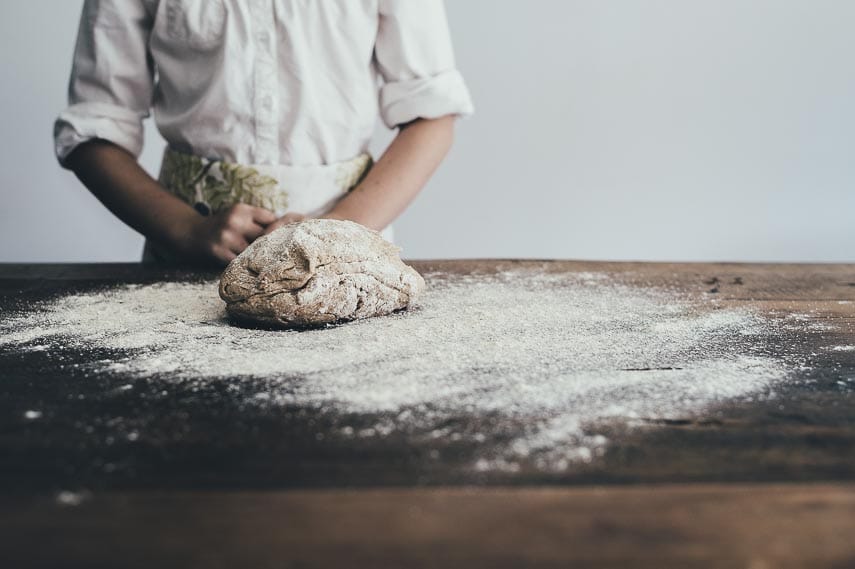
For more information, read our article, The Low FODMAP Diet is Not a Gluten-Free Diet.
When choosing a flour to use while on the Elimination phase, or possibly beyond, there are many factors to take into consideration.
-
Do you want or need it to be gluten-free?
-
Are you using it primarily for cooking (like for thickening sauce, dredging meat) or for baking?
-
Are you sensitive to xanthan gum or other gums?
-
Do you want to avoid dairy products?
-
Looking for the convenience in a ready-made blend?
-
Want to make your own?
Let’s take this one at a time because your answers to each question will lead you down a different path.
Do You Want or Need Your Flour to Be Gluten-Free?
The low FODMAP diet is not a gluten-free diet, however, there is a lot of overlap. All-purpose flour is made from wheat and wheat contains gluten as well as high FODMAP fructans. This is why you will be eating many gluten-free items, especially during Elimination. If you want a gluten-free product you have to look at flours and starches made from grains and foods that are also low FODMAP, which include those made from rice, sorghum, tapioca, potato, corn, buckwheat, millet, quinoa and teff, among others. The problem with these is that used alone they do not mimic the same results as all-purpose wheat-based flour.
Are You Using Flour Primarily for Cooking or Baking?
You might think this is a funny question but if you’re making a birthday cake or chocolate chip cookies you are asking more of your flour than it you are thickening a sauce. When we bake classic sweets and desserts we are used to certain textures and if we are using gluten-free flour the results will most likely be closer to the original recipes if gums are added to the flour blend. Yes, gums and blends. Blends are created to take advantage of the best qualities of each flour and starch and a little bit of gum, often xanthan gum, does a very good job at mimicking the final results we get when using traditional all-purpose flour.
If you are using a flour blend while cooking, dredging meat and the like, then you don’t need gums and some flours or starches can work on their own.
Are You Sensitive to Gums?
If you want to learn more, read our article Are Xanthan & Guar Gum Low FODMAP? The short answer is yes, they are low FODMAP, which is why you will find us using products that contain them. If you have sensitivity to them, then by all means avoid them.
Do You Want to Avoid Dairy Ingredients?
In a flour blend? Yes! Again, as always, you need to read labels. You will notice that many of the names mentioned below like “measure-for-measure” and “1 to 1” are a play off of a gluten-free flour blend created by the Thomas Keller team (of Napa’s French Laundry fame) and it was called “Cup4Cup”.
It created quite a stir in the baking world when it first appeared as it worked quite beautifully in many baked goods, however, it contains milk powder.
Do You Want the Convenience of a Ready-Made Flour Blend?
After running a Test Kitchen and developing recipes for over 30 years I can tell you that I have tried many ready-made gluten-free blends.
Hands down my favorite gluten-free all-purpose flour is Bob’s Red Mill Gluten-Free 1 to 1 Baking Flour (with the blue label). I find that it most closely creates baked goods with the characteristics that most closely resemble those made with regular wheat-based all-purpose flour. It works very well when cooking, too, so it is the one I reach for most often and truly consider “all-purpose”.
Another factor is that it is easy to find for many here in the U.S.
Note that this blend is not the original Bob’s Red Mill Gluten-Free All-Purpose Baking Flour (with the red label), which contains garbanzo bean (chick pea) flour. That one is high(er) in FODMAPs and it also has a strong taste that I do not like. It also does not do as great a job with texture of your final baked goods.
If I were to have another low FODMAP flour on hand I would also consider King Arthur Flour Gluten-Free Measure for Measure Flour for one with added gums and Authentic Foods GF Classical Blend for one without gums.
This King Arthur is a good flour, but it is a very soft flour. Although the manufacturer suggests a 1 to 1 replacement for regular all-purpose flour, I have found it to function more like cake or pastry flour.
If I were to be re-creating a recipe that called for cake or pastry flour (which are lower in protein than all-purpose), I would consider using this flour. King Arthur recommends it for “non-yeasted” recipes. Note that this is not the same product as the original King Arthur Gluten-Free All-Purpose Flour (see comparisons below).
The Authentic Foods GF Classical Blend combines brown rice flour, potato starch and tapioca flour for a tidy short ingredient list in a blend that provides a nice, tender crumb, particularly in cakes.
A Special Note On Yeast Baking
As I have been working on yeast-based recipe such as doughnuts, pizza, cinnamon rolls and sticky buns I have greatly enjoyed working with Better Batter All-Purpose Flour. It is a gluten-free blend that is also allergen-free – but the big difference is that it contains pectin. I have found that it gives that desired springy texture that we look for from yeast-raised goods. In fact, I consider it required in certain low-FODMAP baking. I will be specific and call for it in recipes; please use it where it is listed in the ingredients.
And if you are working with your own yeast-raised doughs, I highly recommend trying it.
Do You Want to Make Your Own Flour Blend?
You certainly can and this way you can tailor it to what you need in your kitchen. I will offer a couple of suggestions, to try and cover the bases.
Gum Free Low FODMAP Gluten-Free Flour Blend
FODMAP Everyday® All-Purpose Low FODMAP Gluten-Free Flour (contains xanthan)
If you want to make a version of Better Batter flour, which is unique and contains gelatin, try this one here.
Choices Count
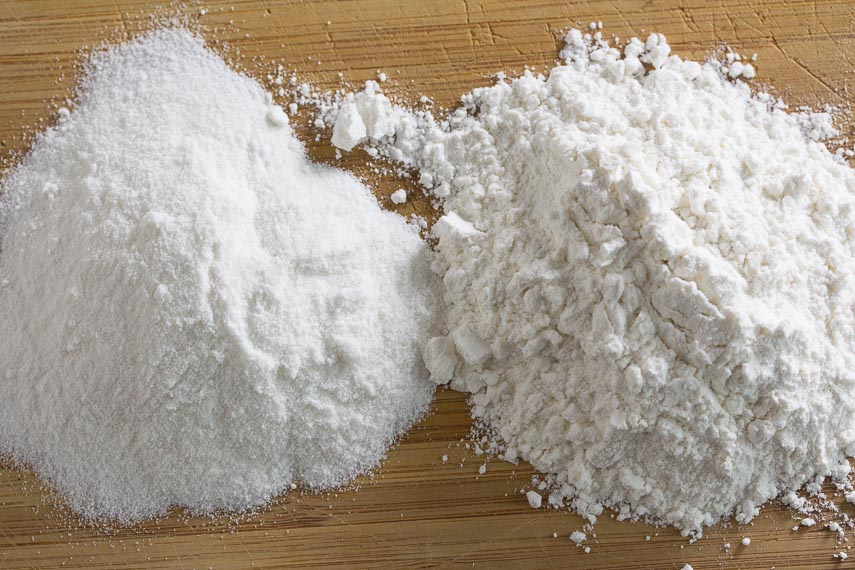
When you are creating a flour blend, you’re choice of individual ingredients can make or break a result. Just look at this chart below. It is not meant to make you crazy (although staring at these varied numbers drives me nuts). It is meant to show you how one rice flour is not necessarily like another. How one brand’s sorghum can differ from another. Our suggestion is to always use the ingredients and brands that are recommended, if indeed specifications are given.
| FLOUR | Bob's Red Mill | Arrowhead Mills | Authentic Foods | King Arthur Flour | Hodgson Mill | ||
|---|---|---|---|---|---|---|---|
| White rice | ¼ cup = 40 g 1 cup = 160 g | ¼ cup = 26 g 1 cup = 105 g | ¼ cup = 40 g 1 cup = 160 g | 1/ cup = 36 g 1 cup = 142 g | ¼ cup = 40 g 1 cup = 160 g | ||
| Sweet white rice | ¼ cup = 51 g 1 cup = 204 g | ¼ cup = 30 g 1 cup = 120 g | |||||
| Brown Rice | ¼ cup = 40 g 1 cup = 160 g | ¼ cup = 26 g 1 cup = 105 g | ¼ cup = 40 g 1 cup = 160 g | ¼ cup = 32 g 1 cup = 128 g | ¼ cup = 30 g 1 cup = 120 g | ||
| Sorghum | ¼ cup = 34 g 1 cup = 136 g | ¼ cup = 44 g 1 cup = 176 g | ¼ cup = 35 g 1 cup = 138 g | ||||
| Tapioca Flour (Starch) | ¼ cup = 30 g 1 cup = 120 g | ¼ cup = 32 g 1 cup = 128 g | ¼ cup = 40 g 1 cup = 160 g | ¼ cup = 27 g 1 cup = 107 g | ¼ cup = 30 g 1 cup = 120 g | ||
| Potato starch | ¼ cup = 48 g 1 cup = 192 g | ¼ cup = 40 g 1 cup = 160 g | ¼ cup = 38 g 1 cup = 152 g |
At a Glance Ingredients
Here are the ingredients for some of the flours mentioned as well as some others that are popular. Some are low FODMAP and some are not; I have included some commentary:
Bob’s Red Mill Gluten-Free 1 to 1 Baking Flour: sweet rice flour, whole grain brown rice flour, potato starch, whole grain sweet white sorghum flour, tapioca flour, xanthan gum.
Bob’s Red Mill Gluten-Free All-Purpose Baking Flour: garbanzo bean flour, potato starch, tapioca flour, whole grain sweet white sorghum flour, fava bean flour
King Arthur Flour Gluten-Free Measure for Measure Flour: rice flour, whole grain brown rice flour, whole sorghum flour, tapioca starch, potato starch, cellulose, xanthan gum, vitamin and mineral blend [calcium carbonate, niacinamide (vitamin B3), reduced iron, thiamin hydrochloride (vitamin B1) riboflavin (vitamin B2)]. It is non-GMO sourced and Certified Gluten-Free.
Better Batter Gluten Free Flour: rice flour, brown rice flour, tapioca starch, potato starch, potato flour, xanthan gum, pectin (lemon derivative). Top 8 free, GMO free, kosher (OU pareve), vegan appropriate.
King Arthur Gluten-Free All-Purpose Flour: rice flour, tapioca starch, potato starch, whole grain brown rice flour, vitamin and mineral blend [calcium carbonate, niacinamide (vitamin B3), reduced iron, thiamin hydrochloride (vitamin B1) riboflavin (vitamin B2)]. It is non-GMO sourced and Certified Gluten-Free.
Authentic Foods GF Classical Blend: brown rice flour, potato starch, tapioca flour. Non-GMO and free of gums. Dairy free, nut free, corn free and soy free.
Authentic Foods Steve’s Cake Flour Blend: rice Flour, potato, tapioca, AF natural fiber blend. Editors Note: We contacted Authentic Foods to discuss their “AF natural fiber blend” and they have shared with us that it is combination of psyllium and cellulose. According to Monash University, even though cellulose is an insoluble fiber and psyllium is a soluble fiber, both are considered to be less “gas forming” than other fibers. We love this product and believe it is worth trying.
Namaste Gluten-Free Perfect Flour Blend: sweet brown rice flour, tapioca starch, brown rice flour, arrowroot flour, sorghum flour and xanthan gum. Non-GMO, vegan, casein-free and dairy-free.
Pamela’s Gluten-Free Artisan Blend All-Purpose Flour: brown rice flour, tapioca starch, white rice flour, potato starch, sorghum flour, arrowroot starch, guar gum, sweet rice flour, rice bran. Non-GMO, Non-Dairy, Certified Gluten-Free
Cup4Cup Gluten-Free Multipurpose Flour: cornstarch, white rice flour, brown rice flour, rBST-Free milk powder, tapioca flour, potato starch, xanthan gum. Non-GMO, Certified Gluten-Free, Made in USA, Kosher.
Cup4Cup Gluten-Free Wholesome Flour: brown rice flour, white rice flour, ground golden flaxseed, rice bran, xanthan gum. Non-GMO, Dairy Free, Certified Gluten-Free, Made in USA, Kosher.
Arrowhead Mills Organic Gluten-Free All Purpose Flour: organic rice flour, organic brown rice flour, organic tapioca flour, organic millet flour, organic inulin, xanthan gum. Non-GMO, Certified Gluten-Free. (Editor’s Note: inulin is high FODMAP).
Arrowhead Mills Organic Gluten-Free Heritage Blend All Purpose Flour: organic rice flour, whole grain sorghum flour, organic tapioca starch flour, organic whole grain sorghum flour, leavening (sodium acid pyrophosphate, baking powder, monocalcium phosphate), inulin, rice bran extract, xanthan gum. Non-GMO, Certified Gluten-Free. (Editor’s Note: inulin is high FODMAP; we also do not recommend brands with leaveners).
Glutino All-Purpose Baking Flour: white rice flour, potato starch, tapioca starch, pea hull fiber, acacia gum, rice protein. Non-GMO.
Krusteaz Gluten Free All Purpose Flour: This is a sorghum heavy blend with no gums; some community members have enjoyed using it: Whole grain sorghum flour, brown rice flour (rice flour, stabilized rice bran with germ), whole grain millet flour, rice flour. Contains 2% or less of the following: food starch-modified, whole grain quinoa flour, xanthan gum.
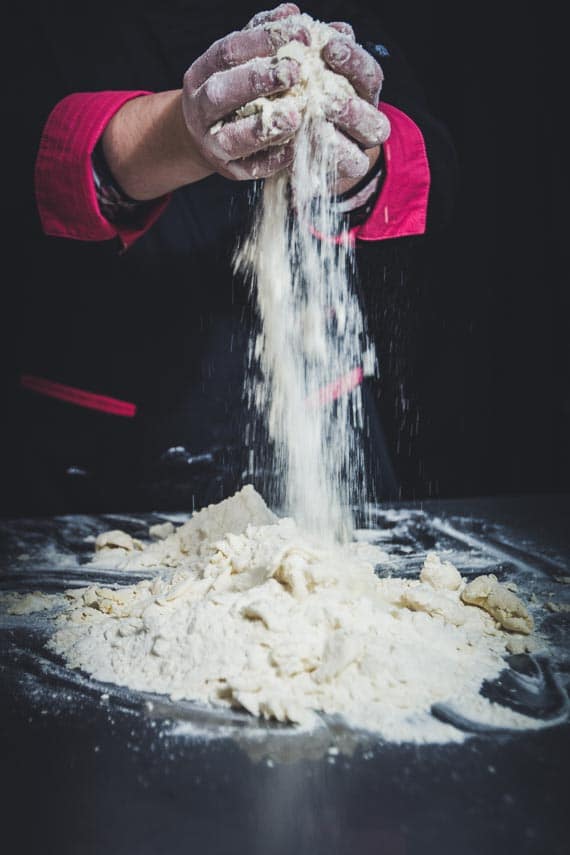
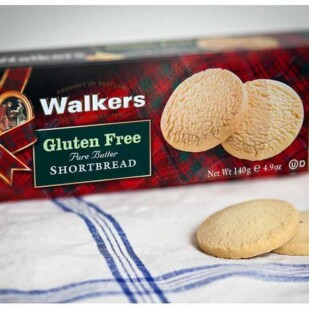
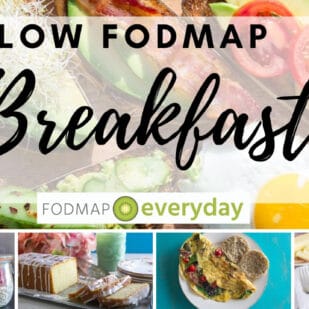






Hi, just to let you know, you have a typo in your article about gluten free flour. Your post says that gums are not low-fodmap (while linking to an article that says that they are).
All fixed. Thank you.
I’m new to all of this and fairly confused. I just bought bob’s red mill original gluten free flour but based on your review I plan to exchange it for the 1:1 GF flour—thanks!
But, what about oat flour? Is that low fodmap and is a good flour (all by itself) to make with…ie for cookies or bars?
Thanks in advance
Louis, oats can be low FODMAP in low portions and those amounts are not usually “enough” to be the whole “flour” in a baking recipe. In addition, oat flour alone is going to be Very heavy and not similar to traditional all-purpose flour in texture or flavor at all. This is why we like blends, such as the 1 to 1! Hope the article was clarifying.
Hi! I’m new to the low fodmap diet and I’m trying to find a gluten free flour mix in Canada. Robin Hood gluten free flour contains rice flour, potatoe starch, pea fiber, tapioca starch, xanthan gum. I know most of the ingredients are safe but what about pea fiber. Is pea fiber low fodmap? Any help would be greatly appreciated. Thanks!
Hi Kimberly, thank you for writing. Peas and pea products are a funny thing. Peas themselves are High FODMAP, yet we can have them in small amounts, which we put to great use in our Tuna Noodle Casserole. Pea protein has been approved by Monash University and is used in many snack bars and “high protein” products. Pea fiber, however, is a different story. It has not been tested and I would suggest finding another flour blend. Or, you could make your own, following our recipes.
Thanks so much for your quick reply! I found another brand that is similar to Bob’s Red Mill 1 to 1 so I think I’ll give that one a try. It contains sweet white rice flour, brown rice flour, potato starch, sorghum flour, tapioca flour, xanthan gum, so I thinkbit should be safe ☺ Thanks again!
Sounds like it should work and be a keeper!
Hi! I’ve been using the Bob’s Red Mill 1-to-1 Gluten-Free flour; and, while it seems to work just fine as an AP flour substitute, I’m having issues with cakes and quick breads. I recently made two different banana breads where I subbed AP flour with the GF flour, and both ended up having to be in the oven for—at minimum—3 hours longer than the recipe stated. I even lowered the oven temp by 25 degrees, partially due to the fact that I was using a dark pan but also because I read that you might need to do that with GF flour. My banana bread still came out overcooked on the top and edges (I rented the top with foil after an hour), and undercooked in the center.
Any idea what might be the issue? My baking powder and baking soda are new. Thx!
Hi JTM, I am assuming you are not using one of our recipes as you state that it began by recommending AP. What I would do is make the recipe with AP and see if the recipe even actually works. There are plenty of poorly developed recipes out there. If it works with the AP, you then know that simply swapping out the LOFO GF flour was the issue – and it is not unusual for tweaking recipes, especially when going from conventional to GF that there would be issues. I would get an oven thermometer, too. BUT 3 hours for banana bread makes no sense at all. I would also look at the temperature of my ingredients. Ice cold butter/eggs/partially frozen bananas etc. would create issues – but not 3 hours worth of issues . Cookies, being small would cook more quickly no matter what. Another thing is that banana bread can get pretty you some ideas. You could also reference our baking book where I discuss substitutions quite a bit.
That was supposed to say that it works just fine as a sub for AP flour when making cookies. 😉
Thank you for this! Everything I wanted and needed to know in one place!
YAY! That was my intention:) Happy baking!
Thank you; what an informative article detailing all the various gluten free flours. Appreciate your time and expertise!
Third and Windsor Interior Design
Hi Sharon, thank you and happy baking.
I have IBS and have found that even brown rice and any kind of potato is a trigger for me. What flour would you recommend?
Hi Aaron, since we focus on low FODMAP, and potato and rice products are low FODMAP, I have no further suggestions for you. This is the exact kind of issue that can worked out with a RD and why it is best to work with one. We have an International Directory for you.
I see you mentioned texture in your comments re outcomes when using gluten free/lowfodmap blends of flour when baking. Since beginning Low Fodmap dietary modifications, I have baked twice, cookies and muffins, using Bob’s Redmill 1:1 Gluten free flour. The results were tasty and flavorful, but I find the texture to be somewhat “grainy” in my opinion. I am a lover of baked goods and have been without since beginning this dietary change and was hopeful the substitute would be a successful one. The grainy outcome of my baking is a turn off for future attempts. Is this what you experience when you mention “textures”? Thank you!
Hi Ginger, rice flours are grainy and most GF blends use them in a high proportion. The blend you used is actually one of the better ones to mitigate this factor. You definitely want to stick with blends that contain xanthan gum, as without it, the grainy texture is more pronounced. You could certainly try others like the King Arthur Measure for Measure, which is more like a cake flour, or the Better Batter, which is a product until itself with the inclusion of pectin. Do not merely sub that one in recipes not developed specifically for it. I like it in yeast recipes. In general the hydration has to be upped quite a bit. Also it does not brown as much, which can work for you – like in cinnamon buns – or against you, as in chocolate chip cookies. Our Baking Ebook is 275 pages of unique recipes not found on the site and has a lot of information on substitutions and baking in general which
Thank you! I appreciate your feedback….I will check our your Baking ebook!
Excellent! Let me know if you have any questions.
Hello, I use a flour blend developed by America’s Test Kitchen (ATK) and so far, following their recipe instructions, everything has turned out very well. One tip they give is to let your product sit for 30 minutes before baking to allow the flours to absorb the liquid, which eliminates the grainy texture. Just allow extra time to get a better product. It works for me.
I’ve tried a lot of different blends that sadly failed. In Canada, these flours are expensive. Not getting the expected results is very disappointing and wasteful.
I hope this helps.
Patricia
Hi Patricia, I had an experience many years ago when I was on book tour with my Christmas cookie book and I came up to Canada. The local food stylist had made my cookies and none of them were “right” and they were all different from when I would make them. It was the flours…all we can do is work with what we have. I used to work with the ATK folks (developing recipes) and am well versed with the “wait”. I too find that it helps on occasion, but not always. Baking is a creative adventure!
Wondering if you’ve tried Krusteaz gluten free flour blend. It is more affordable than many others. I’ve had very good results with it so far. I made the chocolate chip cookie recipe from their bag (added pecans) and my family devoured them (and nobody but me needs to be low FODMAP).
If you are having great results, then that is fantastic! It would be considered low FODMAP. Use your Monash app to help you determine.
Hi Dede,
Thank you for this post! I didn’t see anything with flour blends that contain legumes like garbanzo beans or Fava beans for example. Can you advise on these? Are they low fodmap when used in baking? TIA!
Hi Keila, the blends that you mention contain high FODMAP ingredients and were not mentioned both for that reason and also because I do not like the results that they give in baked goods.
Hi, I was wondering if you’ve heard of and or used the logo pantry flour from Australia? I ordered some and used it to make pancakes using their recipe. But they came out really thick and heavy. I did cut the recipe in half because it’s just me. But I wasn’t sure if that’s the norm for this flour or if it was user error, but I felt like I followed the recipe exactly.
Hi there! Their flour is wheat based and a unique product. I have asked them several times over the years to send some product for us to play with in the test kitchen, to no avail. I would certainly not try to sub their product for another, but you said you used their recipe, which of course should work. That said, not all recipes are developed well…I would reach out to them and discuss your process and results and see what they say.
Thank you so much for responding. You are absolutely right when you say not all recipes are developed well. I decided to use the flour in my family pancake recipe and it was definitely very different results. I did obtain fluffy pancakes.
Sorry I didn’t notice that the auto correct changed something. The flour I used is the Lofo Pantry Plain flour. It’s from a company in Australia.
Hi, have you heard anything about the Miss Jones Baking Co. sea salt chocolate chip cookie mix being good/bad for low FODMAP? I’m confused because it has pastry flour ie wheat, but on the Spoonful low FODMAP app it’s showing green/compliant. I bought a bag but now I’m second guessing it!
Hi there! I just looked it up. What a frustrating ingredient list. We assume they mean “wheat” pastry flour…the only thing I can think is that since about 25 g of wheat flour is considered low FODMAP and each cookie totals 22g in weight (including other ingredients) maybe that is how Spoonful is coming up with a low FODMAP notation. If you are not celiac, you could try it.
Can you have small amounts of all-purpose regular flour if it’s just used for something like breading on fried calamari?
Wheat does have low FODMAP serving sizes. It contains fructans and everyone’s tolerance varies. You could try, but as you know, it is easy to eat a lot of fried calamari at once! Have you tried our calamari recipe? It’s awesome! Wheat bread in the Monash app is low FODMAP in 1 slice, which is about 25 to 30 g…you could try that much flour and see.
I just nade a nice GF loaf of bread with Pamela’s bread mix. Is her mix low fodmap? If not, another item in my freezer I cannot eat. Thanks.
Her bread mix is not Low FODMAP. It contains inulin. There are also 9 g of sugar, so there is possibly a high FODMAP serving of honey as well, but even with just the inulin it would not be considered Low FODMAP.
Do you have a potato free blend suggestion to make myself?
I do not. You could try our flour blend and use more tapioca flour.